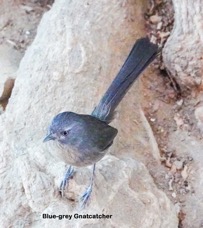Blue-grey Gnatcatcher

ComingsBirds.com
to the beauty of birds

- Home California Birds
- SLIDESHOW
- SUMMARY OF ALL BIRDS
- MOVIES
- American Avocet
- American Coot
- Blackbirds/Crows
- Blue-grey gnatcatcher
- Brant
- Brown Pelican
- Chickade Mountain
- Comings' Backyard
- Common Loon
- Curlew Long-billed
- Dowitcher Long-billed
- Dowitcher Short-billed
- DUCKS
- EGRETS
- Dunlin
- Godwit Marbled
- Goldfinch Lesser
- GREBES
- Gnatcatcher Blue-grey
- Grosbeak Black-headed
- Gull California
- HUMMINGBIRDS
- Gull Heermann's
- Heron Black-crowned
- Heron Great Blue
- House Finch
- Jays
- Killdeer
- Merganser Red-breasted
- Nutcracker Clark's
- NutmegMannikin.com
- Other Birds
- Phainopepla
- Phoebe Say's
- Plover Black-bellied
- Plover Western Snowy
- Quail California
- Kittywake Black-legged
- Recent Additions
- Roadrunner Greater
- Sandpiper Least
- Sandpiper Western
- Sally's Fish
- Sanderling
- Shore Birds Other
- Skimmer Black
- Sparrow White-crowned
- Song Sparrow
- Stilt Black-necked
- Surf Scoter
- Swallow Tree
- Teal Blue-winged
- Teal Green-Winged
- Teal Cinnamon
- Tern Common
- Tern Elegant
- Turnstone Black
- Turnstone Ruddy
- Western Meadowlark
- Whimbrel
- Willet
- Yellow Leggs
- WOODPECKERS
- Template
- Contact Me
The Blue-gray Gnatcatcher (Polioptila caerulea) is a very small songbird,3.9–5.1 in length and weighing only 0.18–0.25 oz. Adult males are blue-gray on the upperparts with white underparts, have a slender dark bill, and a long black tail edged in white. Females are less blue, while juveniles are greenish-gray. Both sexes have a white eye ring.
The blue-gray gnatcatcher's breeding habitat includes open deciduous woods and shrublands in southern Ontario, the eastern and southwestern United States, and Mexico. Though gnatcatcher species are common and increasing in number while expanding to the northeast, it is the only one to breed in Eastern North America. Both parents build a cone-like nest on a horizontal tree branch, and share feeding the young. The incubation period is 13 days for both sexes, and two broods may be raised in a season.
They forage actively in trees or shrubs, mainly eating insects, insect eggs and spiders. They may hover over foliage (gleaning), or fly to catch insects in flight (hawking).
The tail is often held upright while defending territory or searching for food.
The songs (and calls) are often heard on breeding grounds, (usually away from nest) and occasionally heard other times of the year. Both parents build a cone-like nest on a horizontal tree branch, and share feeding the young. The incubation period is 13 days for both sexes and two broods may be raised in a season.
© 2009 David Comings Contact Me




